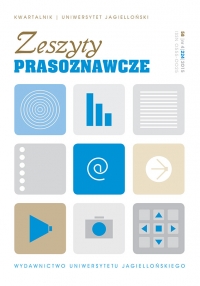Dobrzy i źli bracia. Obraz Czechów i Słowaków w publicystyce II Rzeczypospolitej
Good and Bad Brothers. Czechs & Slovaks’ Image in the Journalism of the Second Commonwealth of Poland
Author(s): Remigiusz KasprzyckiSubject(s): Media studies, Political history, Cultural Anthropology / Ethnology, Pre-WW I & WW I (1900 -1919), Interwar Period (1920 - 1939)
Published by: Wydawnictwo Uniwersytetu Jagiellońskiego
Keywords: Czechs; Slovaks; Poland; Czechoslovakia; nation; journalism; Polish press;
Summary/Abstract: The image of Czechs in the journalism of the Second Polish Republic varied. Mainly due to the influence of political events. If in 1926– 1934 Czechs were described favourably, then after 1934 their image strongly deteriorated. The unresolved Polish- Czech conflict relating to Zaolzie played a significant role here. Polish press watching the downfall of Czechoslovakia between October 1938 and March 1939 was jubilating and pointing out the cowardice of Czechs. The stereotype of Schweiks, of nation giving up their independence without fighting was predominating in the Polish journalism at that time. Nevertheless, there were some Polish journalists who sympathized with Czechs and wrote about them in a different way. Slovaks were definitely more popular in 1918– 1939. From the very beginning of Polish- Slovak brotherhood their spiritual union was emphasized (Catholicism, conservatism, etc.). Slovaks were described in the spirit of friendship but at the same time they were trifled with. The brotherly nation was neither historic nor competing with Poles. Special fondness towards Slovaks was observed in Polish journalism in the end of ’30s. However, during the formation of Slovakia the voice of criticism towards Slovaks was present in Poland, though this was not the voice of majority.
Journal: Zeszyty Prasoznawcze
- Issue Year: 2015
- Issue No: 4 (224)
- Page Range: 905 - 929
- Page Count: 25
- Language: Polish

